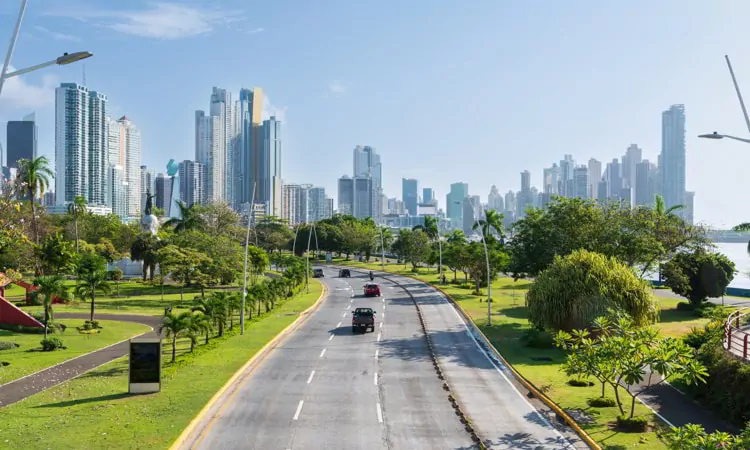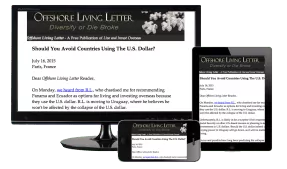
Why Panama City Continues To Be A Great Place To Invest
#1 Offshore Choice
Imagine a country that uses the very same currency you do now… A business hub that’s at the center of the world… with tax advantages you won’t find back home… and a banking sector that has never had a single crisis.
On top of this: it’s a tropical paradise with year-round warm weather, some of the finest beaches on the planet… Its capital has skyscrapers that reach the clouds, and all the culture and excitement you can handle.
You don’t have to imagine this place. It’s real.
It’s not Hong Kong, or Singapore, or Dubai (none of these global business hubs uses the U.S. dollar)… It’s much closer to home.
I’m talking about Panama.
It’s the place where my business and a lot of my life has been based for over a decade… And I repeatedly revisit the reasons why I’ve made this my personal hub for an offshore life.
It’s on my mind again as I look ahead to our Live And Invest In Panama conference, taking place Wednesday to Friday this week.
Not long ago, I spent a weekend afternoon at target practice with my good friend, Panamanian businessman José Bern.
He had some important insights on what led to Panama’s rise… and some of it might surprise you…
"Survivor" and "Miss Universe"
“A series of things happened about 15 years ago,” José reminded me, “that helped to put Panama on the map. First was three seasons of the TV series ‘Survivor.'”
Seasons 7, 8, and 12 of the reality show were filmed here. That really helped introduce American audiences to the beauty of the isthmus, and was a boon to tourism—and ultimately business, as business travelers got to know the country…
“Then we had the ‘Miss Universe’ pageant,” José adds.
The blockbuster beauty contest was held along the Panama Canal in the 2000s, once again drawing the eyes of the world to this small country of 4 million people.
“Wonders of the Universe Meet Wonder of the World” ran a headline on a Panama Canal news website at the time.
The “Wonder of the World,” of course, is the Canal—officially named one of the seven Wonders of the Modern World and a Monument of the Millennium by the American Society of Civil Engineers.
Panama’s origins as a global hub can be traced back even further than José imagines… right back to the canal, which was completed in 1914.
As the First World War broke out across Europe and that continent “fell into darkness,” this engineering achievement in this tiny Central American country was a beacon of progress. A sign that—though the Great Powers were at war with each other half a world away—there were better days ahead for globalization and peaceful progress through trade…
Today, 6% of all world trade passes through the Canal, some US$270 billion annually, serving 80 countries.
The Panama Canal set up Panama for success… but it was not inevitable that Panama would become the global success story it is today.
That’s down to some sound decision making. Panama has no central bank, so there is no monetary intervention. The maximum rate of income tax is 25%, with income up to US$50,000 taxed at just 15% (and the first US$11,000 exempt entirely).
Panama City’s infrastructure is First World, and it even has a metro system.
Plus, Panama has the second-largest duty-free zone in the world, and the people are pragmatic and business minded.
Panama was “ready for prime time” by the time the eyes of the world turned toward it in the 2000s, thanks to popular culture—and one more factor José reminded me of.
“In 2007–2008 we were given a seat in the Security Council of the UN, alongside China and the United States. Imagine what that meant for this country of 4 million people.
“That was the beginning of Panama’s globalization.”
And it’s gone from strength to strength since then…
The Safe, Stable "Hub of the Americas"
Panama has two big advantages, according to José, which give it an edge for investors and for expat living.
His words sum up exactly what I’ve been saying…
“The only tool we have for managing our economy is attracting foreign direct investment.
“That’s why, 12 years ago, a new law was passed to make it easier for multi-national companies to do business here and to import the foreign labor they need. Procter & Gamble was one of the first to take advantage of it, moving their regional headquarters from Venezuela to Panama City.
“More recently, Estée Lauder, which also moved to Panama to take advantage of the country’s pro-business climate, signed a deal to increase their presence—to double from 35,000 square feet to 70,000 square feet of office space.
“What attracted Procter & Gamble, Estée Lauder, and the dozens of other international companies that have chosen to establish themselves in this country in the first place? They all made extensive studies before making the decision to commit to Panama. And in every case, the choice came down primarily to two things…
“First is Panama’s location.
“Nestlé, for example, has its third-largest operation in Panama City. But they buy almost nothing locally. They source their produce from throughout the Americas… from Canada to Argentina. But it’s all bought through the Panama office. It’s a simple matter of logistics. Of connectivity. Thanks to the Panama Canal and also the continually expanding international airport. Panama is a gateway to the 700 million people of Latin America.”
Second, says José, Panama is an icon of stability in an unstable world.
“Panama is stable. Elsewhere in this part of the world can be kind of choppy with dictators, coups, protests. You’ve heard of Noriega, I’m sure, but he hasn’t been in power for 30 years and now he’s dead.
“Today’s Panama is one of the safest, most stable countries in the world and certainly in the region.
“Whenever there is turmoil in the world,” José concluded, “Panama benefits, and, unfortunately, there is a great deal of turmoil in the world right now.
“In the face of it, Panama is seen as a safe harbor…”
More than two decades since I first took notice of Panama as an investment and lifestyle destination—I’m more bullish than ever on this dynamo of a country.
Lief Simon



